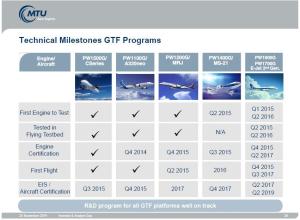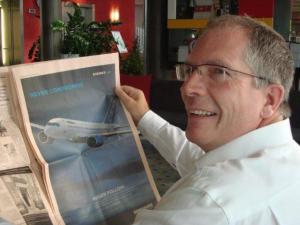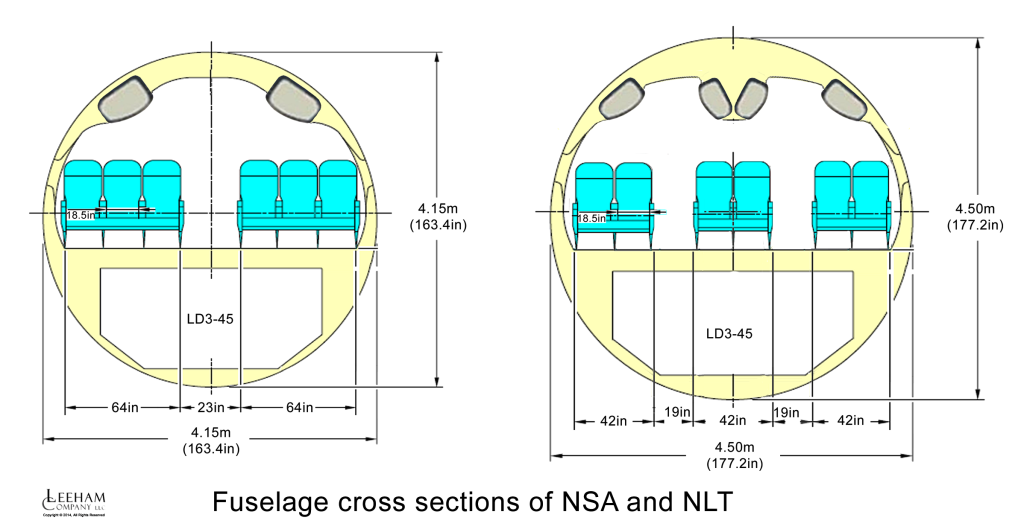Leeham News and Analysis
There's more to real news than a news release.
 Leeham News and Analysis
Leeham News and Analysis
- The Boeing 767 Cross Section, Part 1 November 24, 2022
- Movie Review: Devotion November 21, 2022
- China will accelerate development of its commercial aerospace sector November 21, 2022
- Bjorn’s Corner: Sustainable Air Transport. Part 46. eVTOL comparison with helicopter November 18, 2022
- The economics of a 787-9 and A330-900 at eight or nine abreast November 16, 2022
Boom times leads to looming cash flow shortfall across OEMs
Subscription Required.
Introduction
Dec. 16, 2014: There have been record aircraft orders year after year, swelling the backlogs of Airbus and Boeing to seven years on some product lines, Bombardier’s CSeries is sold out through 2016, Embraer has a good backlog and the engine makers are swamped with new development programs.
So it is with some irony that several Original Equipment Manufacturers (OEMs) are warning of cash flow squeezes in the coming years.
Summary
- With so many development programs in the works, the prospect of new airplane and engine programs are being trimmed.
- Most airframe and engine OEMs under pressure.
- The full impact of the pending cash flow squeeze hasn’t been appreciated by the markets yet.
Posted on December 16, 2014 by Scott Hamilton
Airbus, Boeing, Bombardier, CFM, CSeries, Embraer, GE Aviation, Irkut, Mitsubishi, MTU, Premium, Rolls-Royce
787-10, A320NEO, A330neo, A350, A380, A380-900, A380neo, A400M, air force tanker, Airbus, Boeing, Bombardier, C-17, CFM, Comac, E-Jet E2, Embraer, GE Aviation, GE9X, GTF, Irkut, KC-390, KC-46A, LEAP, Mitsubishi, MTU, Pratt & Whitney, Rolls-Royce
New UTC CEO throws cold water on PW GTF growth
The new chief executive officer of United Technologies Corp., Gregory Hayes, threw cold water on hopes and dreams of Pratt & Whitney, a subsidiary, that the successful small- and medium-sized Geared Turbo Fan will grow into the wide-body market.
Aviation Week just published an article in which all three engine OEMs were reported to be looking at a 40,000 lb engine that would be needed to power a replacement in the category of the Boeing 757 and small 767. Hayes did not specifically rule out a 40,000 lb engine, leaving PW’s potential to compete for this business unclear.
Hayes has been CEO for two weeks. He was previously CFO. He made his remarks in a UTC investors event last night. The Hartford Courant has this report.
Hayes’ remarks were in response to a question from an analyst about research and development expenses. Here is his reply, from a transcript of the event:
Posted on December 12, 2014 by Scott Hamilton
Boeing, Bombardier, CFM, Comac, CSeries, Embraer, Irkut, Mitsubishi, Pratt & Whitney, Rolls-Royce
737 MAX, 757, 757 replacement, 767, 767 replacement, A320NEO, Alain M. Bellemare, Bombardier, C919, CFM, Comac, CSeries, E-Jet E2, Embraer, GE Aviation, Gregory Hayes, GTF, Irkut, MC-21, Mitsubishi, MRJ, Pratt & Whitney, United Technologies
MTU investors day: views of its engine programs, future airplane timelines; separately, Embraer COO interview

Figure 1. Technical milestones have been passed on PW GTF programs for the applications on Bombardier, Airbus, Mitsubishi and Irkut airplanes and are approaching for Embraer. Source: MTU Investors Day. Click to enlarge.
Nov. 30, 2014: MTU Investors Day: MTU is a major participant in engine development and supplies, participating on the GEnx, GTF and GEnx program. It’s also a member of the joint venture in International Aero Engines and it’s a major player in the aftermarket Maintenance, Repair and Overhaul (MRO) sector, providing a serious competitive alternative to the aftermarket contracts offered by the engine OEMs. Its held an investors day conference Nov. 25. Highlights included:
- Milestones have been passed on the Pratt & Whitney Geared Turbo Fanengine for the Bombardier CSeries, Airbus A320neo family, the Mitsubishi MRJ and Irkut MC-21; and are on schedule for the Embraer E-Jet E2.
- The success of the GTF is requiring huge production commitments.
- The large number of airplane/engine programs require a major ramp-up of production during the next few years.
- The major investment in new engines is largely over for now, leading to the expectation of long-term revenue from MRO.
Posted on November 30, 2014 by Scott Hamilton
Odds and Ends: Storm Warnings; Boeing photos now available to everyone; CSeries; Movin’ on up
Nov. 26, 2014:Storm Warnings: We’ve made references in recent posts about airlines on our “Storm Warning Flag” list.

Our 2013 Top Customers and Storm Warning Flag list for wide-body airplanes. The Red are Middle Eastern airlines, blue from Asia and black from the US and Europe. Only one airline for wide-body orders was on our Storm Warning Flag list: AirAsiaX. Expansion and ordering we considered too rapid landed the carrier on the list. Sources: Airbus, Boeing. Click to enlarge.
In 2013, we compiled the Top Customers for Single-Aisle and Twin-Aisle Airplanes for Airbus and Boeing. Here’s our 2013 Storm Warning Flag list. The name comes from the flag, which signals Storm Warnings. This list was compiled before the 777X orders announced at Dubai were firmed up, so the yellow boxes show what the Top 10 Boeing rankings would be had they been. We considered the quantity of orders, the current operations, financial status and other factors in placing a carrier on our Storm Warning Flag list. The Wide-body list also illustrates the growing importance of the Middle Eastern airlines (consider that this was a year ago). The wide-body list is pretty stable.
Posted on November 25, 2014 by Scott Hamilton
Interview: CSeries program update with Bombardier’s program chief Dewar
Subscription required.
Now open to all Readers.
By Bjorn Fehrm and Scott Hamilton
Introduction
Nov. 24, 2014: Bombardier CSeries flight testing has now passed 500 flight hours, and with the addition of Flight Test Vehicle 5 to the test fleet soon, the head of the program believes BBD can hit its entry-into-service target of 2H2015.
Robert Dewar, VP and GM of CSeries, declined to affirm, or even confirm, a report that EIS now has an internal target of October 2015.
In a wide-ranging interview November 24 with Leeham News and Comment, Dewar talked about the flight test program; the repairs to the  composite wing of FTV1 following an engine failure that showered the wing with debris; the Fly By Wire software that’s been nettlesome; and other issues.
composite wing of FTV1 following an engine failure that showered the wing with debris; the Fly By Wire software that’s been nettlesome; and other issues.
Summary
- October 2015 now target for Entry-in-Service, reports Canada’s Desjardins. Dewar reiterated the 2H 2015 target, which remains the company’s official statement.
- Bombardier now has a four test aircraft flying with the fifth joining the test fleet around Christmas time.
- The test aircraft has flown the full flight envelope with the Fly By Wires “normal” mode enabled. Right now the testing is concentrated on the FBW failure modes.
- The next important test series is performance with FTV4, which has production engines fitted for the purpose. FTV4 had just had its first flights when the FTV fleet was grounded for three months following the engine failure in May.
- The final assembly facility is finished with its tooling in July and the first aircraft to be assembled there, the second production aircraft, is presently in final assembly in the facility.
Posted on November 24, 2014 by Scott Hamilton
A320 v 737: the sales winner is….
It’s one of the bitterest rivalries in the industrialized world: Airbus vs Boeing.
Despite being world-class companies, executives at each often snipe at each other’s airplanes, claiming superiority in economics and passenger appeal. Like lawyers arguing a court case, data is typically selectively used to advance the claims.
One of the most hotly debated issues between the two companies is which is the best single-aisle airplane, the ones that fly the most routes in the world and which carry more passengers than any other type: the Airbus A320 or Boeing 737 families.
Boeing’s marketing and communications team has done a superb job of claiming its 737 is the best selling jetliner of all time and with 12,257 firm orders since the first program, the 737-100/200, was launched in 1964. The 737 edges out the A320 family’s 11,021 orders. (These figures exclude options and MOUs.)
But the A320 was launched in 1984, 20 years after the 737. A even-up comparison should begin in March 1984 comparing the A320 family with the 737 Classic from then to the end of the Classic’s production run; and with the 737 Next Generation from its program launch in November 1993; followed by the A320neo and the 737 MAX.
Zhuhai Airshow begins Tuesday: order announcements expected
The Zhuhai Air Show begins next Tuesday and a visit by President Obama to Beijing for a regional summit starts on the last day of the show, Nov. 16. Accordingly, we expect at least some orders to be announced during the show by Airbus, Boeing and perhaps the other airframe OEMs, including the home-grown COMAC, developer of the C919 and parent of AVIC, the developer of the ARJ21.
The Zhuhai Air Show has evolved into China’s premier show. While not on the international reputation and prestige of the long-established Farnborough, Paris and Singapore air shows, it’s become an important must-attend for OEMs and others wanting to do business in China.
Here is our forecast for next weeks’ event.
Posted on November 4, 2014 by Scott Hamilton
Republic Air once again raises doubts about CSeries order, on eve of BBD’s 3Q earnings call
Republic Airways Holdings, a launch customer for the Bombardier CSeries with 40 orders and 40 options for the CS300–the order that prompted Airbus to proceed with the A320neo program, which itself forced Boeing into the 737 MAX–once again raised doubts about the future of its order.
In its 3Q2014 earnings call Oct. 29, on the eve of Bombardier’s own 3Q call on Oct. 30, Republic CEO Bryan Bedford said two carrier certificates would be needed for Republic to operate the CSeries. Republic is moving toward one certificate from multiple certificates to cut costs and simplify operations.
In a transcript of the earnings call prepared by Seeking Alpha, Bedford addressed the CSeries in response to an analyst question:
Posted on October 30, 2014 by Scott Hamilton
Part 3: Boeing 757 replacement: 757 and Airbus A321neoLR versus clean sheet designs.
Subscription required.
By Bjorn Fehrm
Part 3 of 3
Introduction
In Part 2 of our three-part 757 Replacement analysis, we took a close look at Airbus’ new 97 tonne take-off weight A321neo, revealed in a world exclusive by  Leeham News and Comment October 21. We analyzed the A321neoLR’s capabilities and limitations when compared to Boeing 757-200W and we saw that it could do the international flights that the 757-200 does with about 25% better efficiency. In this final Part 3, we will now compare the 757 and A321neoLR against what can be Boeing’s reaction, a clean sheet New Single Aisle, NSA, or New Light Twin Aisle, (NLT). First the conclusions from Part 2:
Leeham News and Comment October 21. We analyzed the A321neoLR’s capabilities and limitations when compared to Boeing 757-200W and we saw that it could do the international flights that the 757-200 does with about 25% better efficiency. In this final Part 3, we will now compare the 757 and A321neoLR against what can be Boeing’s reaction, a clean sheet New Single Aisle, NSA, or New Light Twin Aisle, (NLT). First the conclusions from Part 2:
- When using the United Airlines-configured 757-200W international as benchmark, we came within seven seats of the 757 capacity for an A321neoLR. It covered the same range and had trip fuel costs that were 25% lower.
- The per seat fuel costs gave a 22% higher efficiency, which was within 2% of Airbus own figures.
- 737 MAX9 is not suitable for stretch to an international version, not because the wing is not good enough but because the MAX9 cannot bring the wing to an angle at take-off where it can work efficiently; the landing gear is too short.
Summary
For Part 3 we can summarize:
- A New Single Aisle (NSA) or New Light Twin (NLT) which would enter the market in 2025 would be sized at around 200 passengers with subsequent variants covering the 175-225 seat market, all numbers with OEM standard two-class seating. Figure 1 shows the fuselage cross sections we have used in our modelling of NSA and NLT to cover this market segment.
- In order to cover the market segment of the 737, A320 and 757 it would have a range in excess of 4,100nm. We will use 4100nm for our modeling to maximize the comparative efficiency information.
- Its efficiency would be higher than an A321neoLR, primarily due to better engines and a more modern wing.
- The New Light Twin (NLT) wins on comfort and ground turn-around time but pays with a larger fuselage cross section due to the extra aisle. This causes more drag and structural weight, net effect is a reduction in efficiency of around 2.5%.
Posted on October 28, 2014 by Bjorn Fehrm
Email Subscription
Twitter Updates
My TweetsAssociations
Aviation News-Commercial
Commentaries
Companies-Defense
Resources
YouTube
Archives
- November 2022
- October 2022
- September 2022
- August 2022
- July 2022
- June 2022
- May 2022
- April 2022
- March 2022
- February 2022
- January 2022
- December 2021
- November 2021
- October 2021
- September 2021
- August 2021
- July 2021
- June 2021
- May 2021
- April 2021
- March 2021
- February 2021
- January 2021
- December 2020
- November 2020
- October 2020
- September 2020
- August 2020
- July 2020
- June 2020
- May 2020
- April 2020
- March 2020
- February 2020
- January 2020
- December 2019
- November 2019
- October 2019
- September 2019
- August 2019
- July 2019
- June 2019
- May 2019
- April 2019
- March 2019
- February 2019
- January 2019
- December 2018
- November 2018
- October 2018
- September 2018
- August 2018
- July 2018
- June 2018
- May 2018
- April 2018
- March 2018
- February 2018
- January 2018
- December 2017
- November 2017
- October 2017
- September 2017
- August 2017
- July 2017
- June 2017
- May 2017
- April 2017
- March 2017
- February 2017
- January 2017
- December 2016
- November 2016
- October 2016
- September 2016
- August 2016
- July 2016
- June 2016
- May 2016
- April 2016
- March 2016
- February 2016
- January 2016
- December 2015
- November 2015
- October 2015
- September 2015
- August 2015
- July 2015
- June 2015
- May 2015
- April 2015
- March 2015
- February 2015
- January 2015
- December 2014
- November 2014
- October 2014
- September 2014
- August 2014
- July 2014
- June 2014
- May 2014
- April 2014
- March 2014
- February 2014
- January 2014
- December 2013
- November 2013
- October 2013
- September 2013
- August 2013
- July 2013
- June 2013
- May 2013
- April 2013
- March 2013
- February 2013
- January 2013
- December 2012
- November 2012
- October 2012
- September 2012
- August 2012
- July 2012
- June 2012
- May 2012
- April 2012
- March 2012
- February 2012
- January 2012
- December 2011
- November 2011
- October 2011
- September 2011
- August 2011
- July 2011
- June 2011
- May 2011
- April 2011
- March 2011
- February 2011
- January 2011
- December 2010
- November 2010
- October 2010
- September 2010
- August 2010
- July 2010
- June 2010
- May 2010
- April 2010
- March 2010
- February 2010
- January 2010
- December 2009
- November 2009
- October 2009
- September 2009
- August 2009
- July 2009
- June 2009
- May 2009
- April 2009
- March 2009
- February 2009
- January 2009
- December 2008
- November 2008
- October 2008
- September 2008
- August 2008
- July 2008
- June 2008
- May 2008
- April 2008
- March 2008
- February 2008




Odds and Ends: 787 donation; Alenia sues Bombardier over CSeries; 2016 777 delivery slots opening up
787 donation: The Boeing Co. handed over 787 test airplane #3 (ZA003) to the Museum of Flight Saturday in an elaborate ceremony marking an unprecedented donation of a modern airliner to an aviation museum.
Boeing 787 ZA003, which went on a world sales tour, was donated to Seattle’s Museum of Flight Nov. 8, 2014. The logos of customers bracket the #2 door. Photo by Leeham News and Comment. click to enlage.
To be sure, the donation was made possible by the fact that ZA003 (and 002 and 001) can’t be sold due to the massive rework necessary, and these three airplanes have been written off for more than $2bn. But this doesn’t make the event any less significant.
Read more
12 Comments
Posted on November 9, 2014 by Scott Hamilton
Alaska Airlines, American Airlines, Boeing, Bombardier, CSeries, Douglas Aircraft Co, GE Aviation, Leeham News and Comment, Rolls-Royce
707, 727, 737, 747, 787, Air Force One, Air India. 777, Alenia, Boeing, Boeing 40A, Bombardier, Concorde, CSeries, DC-3, Douglas, GE Aviation, GEnx, Lockheed Constellation, Museum of Flight, Rolls-Royce, Shen, Trent 1000, ZA001, ZA002, ZA003